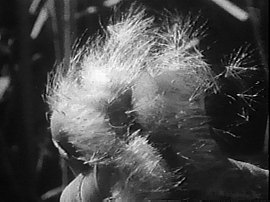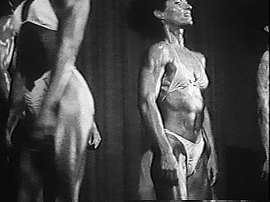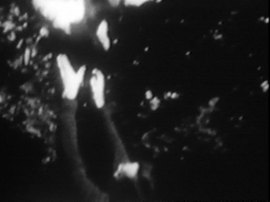Friedrich has remarked that it was only when she began writing about
herself in the third person that it became possible to tell her stories
at all. Perhaps the intensity of the material required that degree of distance;
at any rate, the "she" suggests that we are watching the story of a person
not yet fully formed, not yet ready to assert herself as an "I" in the
world. The awkwardness of the narrator's voice — a young girl reading often
complex texts — is an appropriate additional kind of displacement. However,
the girl's voice varies so frequently in its degree of emotional inflection
that its effect is a little jarring.
The film's variety of connections results in a collage of extraordinary
richness, a portrait of a persona that is somewhat less than unified. As
the adult woman struggles to emerge from the skein of family influences,
she begins to take actions to assert her own autonomy. On a narrative level,
this process climaxes when she decides not to swim across a lake
that her father had often swum (he had also tried to scare her from swimming
in it when she was a child). But on a cinematic level,

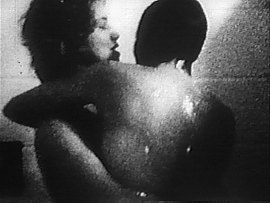 the climax comes
earlier, in a powerful section titled "Kinship." From the point of view
of a traveler, presumably Friedrich, we look through the window of a plane
as it takes off. Then there are images of Death Valley, as our protagonist
walks about accompanied by a friend. Intercut periodically are images of
nude women in a shower and sauna; at one point two women embrace. The little
girl whose father had both introduced her to and made her scared of the
world now has a physicality — an ability to move through space — and a
sexuality of her own.
the climax comes
earlier, in a powerful section titled "Kinship." From the point of view
of a traveler, presumably Friedrich, we look through the window of a plane
as it takes off. Then there are images of Death Valley, as our protagonist
walks about accompanied by a friend. Intercut periodically are images of
nude women in a shower and sauna; at one point two women embrace. The little
girl whose father had both introduced her to and made her scared of the
world now has a physicality — an ability to move through space — and a
sexuality of her own.
But since one of Friedrich's themes is the continual interdependence
of past and present, her film cannot end here. In fact, the sequence just
described is accompanied by a discordant and unexplained  element — a German
art song on the sound track. A few sections later, in "Ghosts," a typewriter
is seen in negative typing out a letter from Friedrich to her father. On
the sound track, instead of the young narrator's voice, we hear the typewriter
keys, giving the section a harshness, even a confrontational directness,
that most of the other sections lack. In the letter, she describes her
mother's loneliness after her father left the family. Mother would rush
the children to bed each evening, and then listen, alone, to an album of
Schubert lieder. Her favorite song was also young Su's favorite, "Gretchen
at the Spinning Wheel" — the song we heard earlier. Friedrich explains
in her letter that she only recently learned the translation of the lyrics,
which describe a woman who years for her absent lover and feels she can't
live without him.
element — a German
art song on the sound track. A few sections later, in "Ghosts," a typewriter
is seen in negative typing out a letter from Friedrich to her father. On
the sound track, instead of the young narrator's voice, we hear the typewriter
keys, giving the section a harshness, even a confrontational directness,
that most of the other sections lack. In the letter, she describes her
mother's loneliness after her father left the family. Mother would rush
the children to bed each evening, and then listen, alone, to an album of
Schubert lieder. Her favorite song was also young Su's favorite, "Gretchen
at the Spinning Wheel" — the song we heard earlier. Friedrich explains
in her letter that she only recently learned the translation of the lyrics,
which describe a woman who years for her absent lover and feels she can't
live without him.
Now — and particularly on a second viewing — we are able to understand
"Kinship" in a new way. The adult Friedrich has defined herself in part
in opposition to the song, as represented by her postdivorce mother: not
at home alone, but seeing the world; not heterosexual, but lesbian. And
yet, as is so often true of Friedrich's connections, the two elements (song
and image) that relate as opposites also relate as identities, for the
sexual footage is intercut with the travel footage, representing a different
time and place: our adult traveler is at the moment, or so it would appear,
also without a lover.
More complete explanations of things seen earlier are offered more than
once in the film. This pattern is a beautiful way of expressing the dependence
of the present on the past: however much one may think one is living in
the present, however ordinary one's present moment may seem, the past will
always return to assert its grip. Nonetheless, the adult Friedrich continues
to struggle to emerge. We see her as an adult for the first time when the
narrator describes the adult Friedrich (now "the woman") observing her
father treat his young daughter, her stepsister, in the same kind of sternly
inconsiderate way that she remembers so well from her own childhood. As
the narrator describes how the woman watched this scene with horror, while
 sipping lemonade, we see the adult Friedrich, alone in her bathtub, perhaps
a bit depressed, drinking beer from a bottle. But witnessing the father-daughter
scene as an adult may have been also liberating: the sequence ends with
the adult Friedrich typing out the story on her typewriter, now seen in
positive rather than the negative of the earlier typewriter sequence. She
has thus finally emerged, from all the displacements of black-and-white
negative, third-person narration, and home movies, as the film's independent
center.
sipping lemonade, we see the adult Friedrich, alone in her bathtub, perhaps
a bit depressed, drinking beer from a bottle. But witnessing the father-daughter
scene as an adult may have been also liberating: the sequence ends with
the adult Friedrich typing out the story on her typewriter, now seen in
positive rather than the negative of the earlier typewriter sequence. She
has thus finally emerged, from all the displacements of black-and-white
negative, third-person narration, and home movies, as the film's independent
center.
Such moments of clarity and independence do not obviate the continual
return of Friedrich's principal persona — a being hopelessly divided, irreparably
torn between present and past, between fantasy and reality, between a remembered
family past and an adult present, forged outside of the family unit. But
such divisions and contradictions should not be seen in a wholly negative
light. What Friedrich cannot be — a person who regards her consciousness
as unified and integrated, and who organizes the world around that consciousness
— is mirrored in what the film's style generally avoids. Its gritty, nonglossy
black and white mimics the look of the home movies that are so prominent
in its imagery. Unlike the static, formal compositions in more conventional
movies, Friedrich's hand-held camera responds to her bodily movements and
attitudes of the moment.
In the films of Stan Brakhage, a similar use of small movements filmed
by a hand-held camera produces a musical rhythm that ultimately imposes
the sense that a single personality, even a single body, is organizing
the world. In contrast to Brakhage's vision of the transcendent self, Friedrich
as well as other younger filmmakers have posited a self that is contingent,
malleable, internally divided, and very much a product of its environment.
In the work of an earlier generation of personal filmmakers the "self"
is taken as a given, springing full-grown like Athena from Zeus's brow;
Friedrich's self is constantly in the process of being formed and reformed,
from the moment the sperm enters the egg, through all her experiences with
her parents, through all the choices she makes — and Sink or Swim
lays that process of formation bare, surrounding the protagonist with the
images and sounds that influence it.
 A humorous moment late in the film speaks directly to Friedrich's conception. The narrator says that after the father left the family, they were able to buy a television, something he had always forbidden, and we see images from Father Knows Best.
In one shot, we see the faces of three scrubbed and smiling kids, all in
a line, object-like as only American mass culture can make them. Friedrich
is making fun of this concept of the happy nuclear family, and the artificial
media image gives Friedrich's personal stories a social dimension as well.
But there is another, deeper joke at work. The compositional perfection
of this image, and the way the children's faces are reduced to objects,
is utterly contrary to the style of Friedrich's film. It contradicts the
style of the home movies she uses, with their jerky images of active children,
but it contradicts the overall space of the film as well.
A humorous moment late in the film speaks directly to Friedrich's conception. The narrator says that after the father left the family, they were able to buy a television, something he had always forbidden, and we see images from Father Knows Best.
In one shot, we see the faces of three scrubbed and smiling kids, all in
a line, object-like as only American mass culture can make them. Friedrich
is making fun of this concept of the happy nuclear family, and the artificial
media image gives Friedrich's personal stories a social dimension as well.
But there is another, deeper joke at work. The compositional perfection
of this image, and the way the children's faces are reduced to objects,
is utterly contrary to the style of Friedrich's film. It contradicts the
style of the home movies she uses, with their jerky images of active children,
but it contradicts the overall space of the film as well.
 In a section titled "Quicksand" the narrator recounts a story about
Friedrich's father forcing her to watch a scary movie. The imagery connects
allusively, rather than directly, to the title and to the story told on
the sound track. We see footage taken from a roller coaster in relatively
short takes and edited with a jagged, unpredictable rhythm; shots rarely
feel as if they are brought to completion. This style combines with the
sweeping movements of the roller coaster to create the feeling of a space
that is continually dividing and breaking apart in ways that cannot be
anticipated — one sees a vision of the world fraught with peril, unexpected
voids, quicksand.
In a section titled "Quicksand" the narrator recounts a story about
Friedrich's father forcing her to watch a scary movie. The imagery connects
allusively, rather than directly, to the title and to the story told on
the sound track. We see footage taken from a roller coaster in relatively
short takes and edited with a jagged, unpredictable rhythm; shots rarely
feel as if they are brought to completion. This style combines with the
sweeping movements of the roller coaster to create the feeling of a space
that is continually dividing and breaking apart in ways that cannot be
anticipated — one sees a vision of the world fraught with peril, unexpected
voids, quicksand.
This vision, of space and of the self, lies at the heart of Sink
or Swim. The surprising and playful stylistic shifts, between home
movies, newly photographed footage, and rephotographed older footage (the
nude women in "Kinship" are from Friedrich's first film); the disparities
and displacements between image and text; the disruption when the text
directly names what is seen in the image — all these suggest nothing less
than the flailings of a beginning swimmer trying to come to terms with
inner and outer chaos. The difference is that through her imaginative control
of her medium, Friedrich has raised those flailings to the level of art,
and in so doing has expressed both their regressive terror and their forward
progress.
In the film's final image she manages not only to combine the diversity
 of her themes in a single cinematic moment, but to go beyond them as well,
with an aching expression of haunting power. The film's reverse alphabet
has just concluded, and we see a shot of Friedrich as a girl, posing for
the camera in a manner rare in the film and vaguely reminiscent of the
shot of the three children from Father
Knows Best. She stands in a bathing suit with an oddly frilly skirt
as an adult voice — Friedrich's own, in fact — begins to sing the ABCs.
Shortly after she begins, the song begins again, her voice superimposed
over itself, in the manner of a round. At the same time the image is superimposed
over itself, paralleling the music, until suddenly all the aural and visual
superimpositions drop out. The child is then seen alone again, in freeze-frame,
while her single voice sings the last line of the song, "Tell me what you
think of me."
of her themes in a single cinematic moment, but to go beyond them as well,
with an aching expression of haunting power. The film's reverse alphabet
has just concluded, and we see a shot of Friedrich as a girl, posing for
the camera in a manner rare in the film and vaguely reminiscent of the
shot of the three children from Father
Knows Best. She stands in a bathing suit with an oddly frilly skirt
as an adult voice — Friedrich's own, in fact — begins to sing the ABCs.
Shortly after she begins, the song begins again, her voice superimposed
over itself, in the manner of a round. At the same time the image is superimposed
over itself, paralleling the music, until suddenly all the aural and visual
superimpositions drop out. The child is then seen alone again, in freeze-frame,
while her single voice sings the last line of the song, "Tell me what you
think of me."
Just as the film itself crosses several genres and contains a variety
of styles, so the film as a whole can be taken in several ways. It is not
only a film about the artist's father, not only an autobiography, but,
as this ending makes clear, it is also a letter to her father, a larger
version of the letter we see her type in the film, which she ends by typing
"P.S. I wish I could mail you this letter." The film, too, is a letter
she cannot send, a letter filled with reproach, criticism, anger, but also
gratitude, even love. The film in fact offers evidence to her father that
in some ways he taught her well: not only does she know her alphabet, but
she knows it backward. But more, the film's incessant story telling is
evidence that the book of Greek myths he gave her as a child and his encouraging
(sometimes undercut by discouraging) her to tell him stories have had their
effect. On one level, the film is a gift to her father, a gift that, in
a contradiction that perhaps mirrors many of the film's smaller contradictions,
she cannot proffer.
Of course, "Tell me what you think of me" is also addressed to the audience
— the filmmaker asking for approval. But perhaps the strongest meanings
to the last line are to be found if one considers it addressed directly
to her father. After all the film's progression, after all the difficulties
that the protagonist endures in order for her adult identity to emerge,
there is something chilling in the way the film reverts to this child's
request for approval at its end. The film and its adult maker know this
terror well, as can be seen by still another aspect of the alphabetical
ordering of the film. The reverse order, in its arbitrariness and oddness,
can be seen as the creative assertion of an adult, taking the things she
has been taught and reordering them in her own way. That she chooses to
order the alphabet in reverse makes the reversion to the "correct" order
in the song all the more horrible: the autonomous adult has once again
reverted to the uncreative child, parroting rather than creating, seeking
approval rather than going off on her own. But in the regression, and in
the obvious contrast between reverse and forward orders, is also the adult's
cry of rage at the way the past keeps returning. She still seeks Daddy's
approval, but she is also enraged that she continues to feel this need.
The film's ending is a cry of protest that a child, an adult, anyone, should
feel such dependency: and so the final image lingers, in the memory, like
a scream that cannot be answered, like an open wound that cannot heal.
Copyright © Fred Camper 1991.
Su Friedrich's Sink or Swim is available for rental from 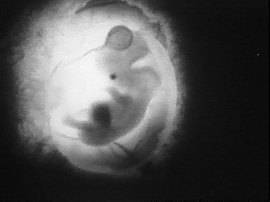
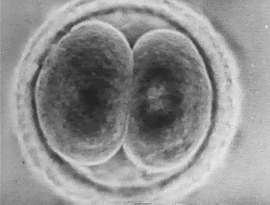 and
finally an embryo. As the zygote begins to divide, the voice of the young
girl begins to tell the story of Athena,
who, unique among Zeus's daughters, sprang full-grown from his brow. The
ironic disparity between the facts of human reproduction as seen in the
imagery and the myth of asexual reproduction heard on the sound track introduces
one of the film's central conflicts, the struggle of a child to create
her own self, in the face of the "facts" of the world that her parents
provide her. This myth and others and stories from Friedrich's own life
are told on the sound track in the third person by the narrator. We soon
find out that when she was very young Friedrich's father gave her
a book of Greek mythology and that she has at least since then been fascinated
by stories.
and
finally an embryo. As the zygote begins to divide, the voice of the young
girl begins to tell the story of Athena,
who, unique among Zeus's daughters, sprang full-grown from his brow. The
ironic disparity between the facts of human reproduction as seen in the
imagery and the myth of asexual reproduction heard on the sound track introduces
one of the film's central conflicts, the struggle of a child to create
her own self, in the face of the "facts" of the world that her parents
provide her. This myth and others and stories from Friedrich's own life
are told on the sound track in the third person by the narrator. We soon
find out that when she was very young Friedrich's father gave her
a book of Greek mythology and that she has at least since then been fascinated
by stories.
